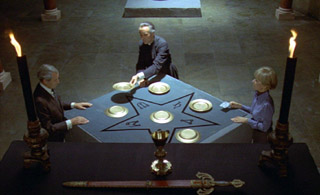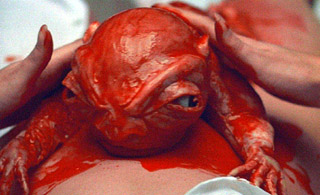|
Hammer's last film seemed like a sure winner on paper.
All the stars and planets seemed to be perfectly aligned for Hammer to end its existence with a screen adaptation of another Wheatley best-seller: To the Devil, a Daughter. Wrong. To begin with, Widmark was difficult. He hated everything about the film from Day 1 and never seemed to develop his character. But the real problems hinged on the script. The earlier Wheatley/Hammer collaboration, The Devil Rides Out, had been brought to the screen as an old-fashioned gothic romance by Richard Matheson, who was himself a successful occult and fantasy novelist (What Dreams may Come, A Stir of Echoes, The Shrinking Man, I am Legend), and screenwriter (16 episodes of the original Twilight Zone, several episodes of Star Trek, Steven Spielberg's Duel, The Night Stalker, and lots more). When it came time to do To the Devil, a Daughter, Matheson was not involved in the project, and the script suffered immensely. I'm not even sure I understand when went on in this movie, or why it ended. The confusing narrative and the hasty ending were caused by the ad hoc development of the script by different writers during the filming. It went something like this: A man (Elliott) cuts a deal to turn his daughter (Kinski) over to the devil on her 18th birthday. As that magical day approaches, when the other guys' daughters all seem to be thinking about their first car and their first day at college, the dad starts to think that maybe his plan for Kinski's life is not a wise one, and maybe it would be better if she explored other, less evil, career avenues, like chartered accountancy. Well, that would be less evil unless she works for Enron. So the old boy does what you and I would do in the same case. He hires an American novelist (Widmark) to help him rescue his daughter from the satanic priest (Lee) who is acting as Satan's agent here on earth. Hey, I know that being Satan's agent sounds like a sinister and pretty cushy job, but have some sympathy for the guy. It isn't easy to be Satan's agent. You think J-Lo is temperamental? The Lord of Darkness makes her seem as amiable and undemanding as Tom Selleck. Plus, you think Satan pays his agents 15%? Hell, no. It's 1%, take it or leave it, and you better not leave it, because, as mild Bruce Banner used to say, you wouldn't like him when he's angry. Anyway, the dad ignores the obvious kind of heroes like cops and bishops and swordsman and such, and wisely hires a novelist to help him defeat Satan, perhaps because the pen is mightier than the sword. All I can say is that the pen may be mightier than the sword, but the ol' Bic would sure get its ass kicked by an AK-47. We see a bunch of flashbacks and dream sequences. Kinski's mother dies in childbirth. Kinski's baptism is the occasion for a special satanic orgy, with all the trimmin's. Then there is a baby who gets his throat slit, and a lady who drains all the blood from her body and stacks it neatly in little bags. Kinski dreams of giving birth to a baby, then shoving it back inside her. Then there is a whole bunch more of satanic mumbo-jumbo, all as dictated by "The Grimoire of Astaroth", a book which includes everything from Satan's middle name to the secret formula for Love Potion Number 9. I knew I should have read that grimoire. I always seem to read those third-rate grimoires, and I really should know better. I mean it's obvious that it could be a valid grimoire if it is written by someone named Astaroth, but the one I read was written by a guy named Phil. And most of his so-called "ye olde magickal inckantations" had to be accessed by calling 1-900 numbers at $4.00 a minute. |
|
|
Oh, well. I think the way the deal works is this: a baby is sold to the devil before it is born. Apparently Satan is willing to buy on spec. When the birth happens, the mother is killed and the baby is s baptized in the blood of its own mother. 18 years later, the grown-up baby is re-baptized in the blood of Astaroth, and thus becomes Astaroth. Or something like that. Before the ultimate transference can be realized, it is imperative for the satanic priests to play the Satanic plate-flip and card game. (Right) Here's a tip: never pass when your partner makes the strong two death opening and you hold a minimum of five sin points. Particularly if your partner is Satan. |
|
|
|
Somebody in the movie spontaneously combusts when
he touches something from Kinski's late mother, then Satan/Astaroth shows up personally, and it turns out he's
actually one of the muppets, possibly even more evil than Bert, albeit
cuter. He's just so gosh-darn cute that Kinski can't resist petting
him, like a collie puppy. (Left) Finally, the evil muppet and the Satanic priest, representing the combined power of all the known evil in the universe, are driven completely from this plane of existence when Richard Widmark simply skips a stone toward them. |


